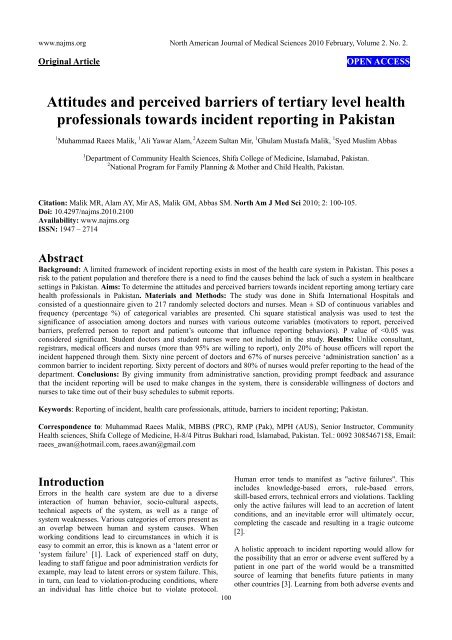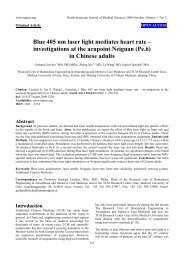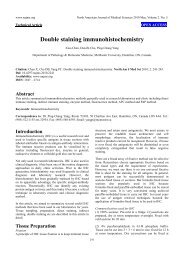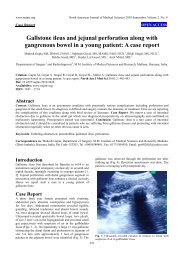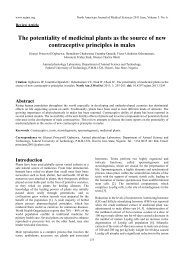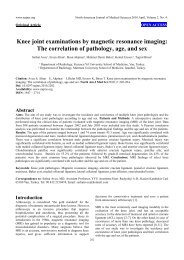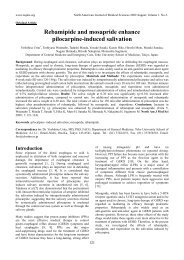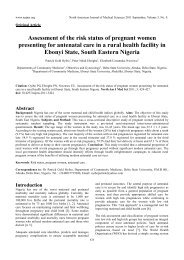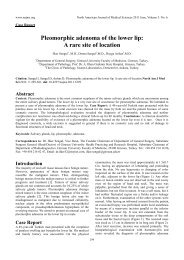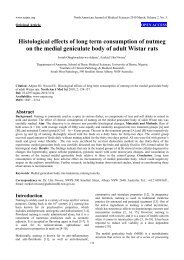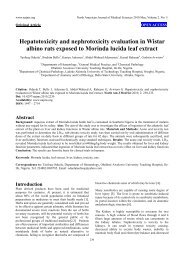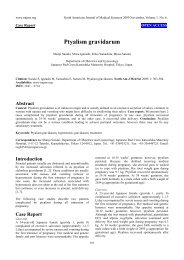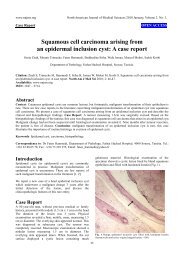Attitudes and perceived barriers of tertiary level health professionals ...
Attitudes and perceived barriers of tertiary level health professionals ...
Attitudes and perceived barriers of tertiary level health professionals ...
Create successful ePaper yourself
Turn your PDF publications into a flip-book with our unique Google optimized e-Paper software.
www.najms.org North American Journal <strong>of</strong> Medical Sciences 2010 February, Volume 2. No. 2.<br />
Original Article<br />
OPEN ACCESS<br />
<strong>Attitudes</strong> <strong>and</strong> <strong>perceived</strong> <strong>barriers</strong> <strong>of</strong> <strong>tertiary</strong> <strong>level</strong> <strong>health</strong><br />
pr<strong>of</strong>essionals towards incident reporting in Pakistan<br />
1 Muhammad Raees Malik, 1 Ali Yawar Alam, 2 Azeem Sultan Mir, 1 Ghulam Mustafa Malik, 1 Syed Muslim Abbas<br />
1 Department <strong>of</strong> Community Health Sciences, Shifa College <strong>of</strong> Medicine, Islamabad, Pakistan.<br />
2 National Program for Family Planning & Mother <strong>and</strong> Child Health, Pakistan.<br />
Citation: Malik MR, Alam AY, Mir AS, Malik GM, Abbas SM. North Am J Med Sci 2010; 2: 100-105.<br />
Doi: 10.4297/najms.2010.2100<br />
Availability: www.najms.org<br />
ISSN: 1947 – 2714<br />
Abstract<br />
Background: A limited framework <strong>of</strong> incident reporting exists in most <strong>of</strong> the <strong>health</strong> care system in Pakistan. This poses a<br />
risk to the patient population <strong>and</strong> therefore there is a need to find the causes behind the lack <strong>of</strong> such a system in <strong>health</strong>care<br />
settings in Pakistan. Aims: To determine the attitudes <strong>and</strong> <strong>perceived</strong> <strong>barriers</strong> towards incident reporting among <strong>tertiary</strong> care<br />
<strong>health</strong> pr<strong>of</strong>essionals in Pakistan. Materials <strong>and</strong> Methods: The study was done in Shifa International Hospitals <strong>and</strong><br />
consisted <strong>of</strong> a questionnaire given to 217 r<strong>and</strong>omly selected doctors <strong>and</strong> nurses. Mean ± SD <strong>of</strong> continuous variables <strong>and</strong><br />
frequency (percentage %) <strong>of</strong> categorical variables are presented. Chi square statistical analysis was used to test the<br />
significance <strong>of</strong> association among doctors <strong>and</strong> nurses with various outcome variables (motivators to report, <strong>perceived</strong><br />
<strong>barriers</strong>, preferred person to report <strong>and</strong> patient’s outcome that influence reporting behaviors). P value <strong>of</strong>
www.najms.org North American Journal <strong>of</strong> Medical Sciences 2010 February, Volume 2. No. 2.<br />
near misses is essential for improving the quality <strong>of</strong> care<br />
however one <strong>of</strong> the greatest frustrations for patients <strong>and</strong><br />
pr<strong>of</strong>essionals alike is the apparent failure <strong>of</strong> the <strong>health</strong> care<br />
systems to learn from their mistakes [2]. Commonly,<br />
neither <strong>health</strong> care pr<strong>of</strong>essionals nor <strong>health</strong> care<br />
organizations counsel others when a mishap occurs, nor do<br />
they share what they have learned when an investigation<br />
has been carried out [4]. Consequently, the same mistakes<br />
occur repeatedly in many settings <strong>and</strong> patients continue to<br />
be harmed by preventable errors. Health-care<br />
organizations <strong>and</strong> individuals benefit from incident<br />
reporting if they receive back useful information, gained<br />
by analysis <strong>of</strong> similar cases at other institutions. If the<br />
event <strong>and</strong> the results <strong>of</strong> the analysis are not reported to an<br />
external authority, the lessons learned are trapped within<br />
the walls <strong>of</strong> that hospital. The opportunity to analyze the<br />
problem is lost <strong>and</strong> the chance to develop more powerful<br />
<strong>and</strong> generalizable solutions is missed [5].<br />
Although the importance <strong>of</strong> incident reporting has been<br />
established, under-reporting remains a significant problem<br />
occurring for example, at a rate <strong>of</strong> 50%–96% annually in<br />
the United States [2, 6, 7]. One solution to this dilemma is<br />
reporting by the primary care providers within the hospital<br />
or <strong>health</strong>-care organization, <strong>and</strong> by the organization to a<br />
broader audience through a system-wide, regional, or<br />
national reporting system [8]. Researchers in the field <strong>of</strong><br />
Quality in Health care believe that an effective reporting<br />
system is the foundation <strong>of</strong> safe practice <strong>and</strong>, within a<br />
hospital or other <strong>health</strong>-care organization, a corner stone<br />
towards achieving a culture <strong>of</strong> safety [9, 10]. At a<br />
minimum, reporting can help identify hazards <strong>and</strong> risks,<br />
<strong>and</strong> provide information as to where the system is<br />
breaking down [11]. This can help target improvement<br />
efforts <strong>and</strong> systems changes to reduce the likelihood <strong>of</strong><br />
injury to future patients.<br />
Extensive work has been done in the west regarding the<br />
role <strong>of</strong> incident reporting systems in preventing harm to<br />
patients thus improving the quality <strong>and</strong> safety <strong>of</strong> <strong>health</strong><br />
care.<br />
A report prepared for the Department <strong>of</strong> Health in the UK<br />
[4] indicated that an adverse event was associated with<br />
10% <strong>of</strong> hospital admissions. With over 850,000 events per<br />
year, costing more than £2 billion per year in direct <strong>health</strong><br />
care costs. In one year, errors involving medical devices<br />
led to death or serious injury in 400 people. The cost <strong>of</strong><br />
hospital-acquired infection was over £1 billion in direct<br />
<strong>health</strong> care costs alone, <strong>of</strong> which 15% were considered to<br />
be preventable. Clinical negligence claims currently<br />
amount to £400 million annually, with an estimated<br />
potential liability <strong>of</strong> £2.4 billion in existing <strong>and</strong> expected<br />
claims [12].<br />
In the United States, analysis <strong>of</strong> the Harvard Medical<br />
Practice study <strong>of</strong> 1984 medical records <strong>and</strong> the<br />
Colorado/Utah study <strong>of</strong> 1992 records showed adverse<br />
events to have been associated with 3.7% <strong>and</strong> 2.9% <strong>of</strong><br />
admissions, 13.6% <strong>and</strong> 8.8% deaths respectively [12].<br />
Peer review indicated that 55% <strong>of</strong> these events were<br />
preventable, <strong>and</strong> almost 28% were due to negligence.<br />
Medication errors, technical errors, diagnostic errors <strong>and</strong><br />
failure to prevent injury were the most common type <strong>of</strong><br />
incidences reported. This report estimated that the total<br />
cost <strong>of</strong> preventable adverse events is between $17 billion<br />
<strong>and</strong> $29 billion, with direct <strong>health</strong> care costs accounting<br />
for over half.<br />
Results from the Quality in Australian Health Care Study<br />
<strong>of</strong> 1995 show similar results [13]. Adverse events were<br />
associated with 16.6% <strong>of</strong> hospital admissions (with<br />
approximately half leading to the admission, <strong>and</strong> half<br />
occurring during the admission), 4.9% mortality <strong>and</strong><br />
permanent disability in 13.7%. Of all adverse events, 51%<br />
were deemed to be highly preventable. The preventable<br />
cost <strong>of</strong> adverse events may be as much as $2 billion<br />
annually, or 5% <strong>of</strong> the $40 billion spent each year on<br />
<strong>health</strong> care. In addition, costs arising from legal expenses<br />
<strong>and</strong> compensation for medical error currently total $400<br />
million per year, which consumes a further 1% <strong>of</strong> the<br />
<strong>health</strong> budget [14].<br />
Since the publication <strong>of</strong> the US Institute <strong>of</strong> Medicine<br />
report ‘‘to err is human’’ [12], <strong>and</strong> the UK Department <strong>of</strong><br />
Health report ‘‘an organization with a memory’’ [1], there<br />
has been increasing recognition <strong>of</strong> the need for <strong>health</strong>care<br />
organizations to monitor <strong>and</strong> learn from patient safety<br />
incidents. Over the last few years, several countries have<br />
established national or system-wide reporting systems to<br />
facilitate large scale monitoring <strong>and</strong> analysis <strong>of</strong> incident<br />
data [15-17]. The National Reporting <strong>and</strong> Learning System<br />
(NRLS) for Engl<strong>and</strong> <strong>and</strong> in Wales, established by the<br />
National Patient Safety Agency, was rolled out in late 2003<br />
<strong>and</strong> has now received over one million reports, mainly<br />
from acute hospitals [18-19].<br />
Limited framework for incident reporting system exists in<br />
most <strong>of</strong> the <strong>health</strong> care system in Pakistan <strong>and</strong> therefore<br />
poses risk to the patients <strong>and</strong> results in compromised<br />
quality <strong>of</strong> care. Development <strong>of</strong> a nationwide incident<br />
reporting system is inevitable in Pakistan. Recognizing the<br />
attitudes <strong>and</strong> perceptions <strong>of</strong> <strong>health</strong> pr<strong>of</strong>essionals who will<br />
implement this system is m<strong>and</strong>atory for its success. This<br />
study aims assess the attitudes <strong>and</strong> perceptions <strong>of</strong> doctors<br />
<strong>and</strong> nurses towards incident/error reporting in <strong>tertiary</strong> <strong>level</strong><br />
<strong>health</strong> care <strong>of</strong> Pakistan <strong>and</strong> to identify potential <strong>barriers</strong> at<br />
the grass root <strong>level</strong> to the implementation <strong>of</strong> an error<br />
reporting system. To the best <strong>of</strong> our knowledge similar<br />
studies have not been conducted in Pakistan.<br />
Materials <strong>and</strong> Methods<br />
The study was conducted in Shifa International Hospital<br />
(SIH), a 600 bed <strong>tertiary</strong> care facility, employing 520<br />
registered <strong>health</strong> pr<strong>of</strong>essionals. EPI-info 6.0 was used to<br />
calculate the sample size. Fifty percent reporting <strong>of</strong> error<br />
was taken as identified factor. For 95% confidence interval<br />
<strong>and</strong> precision <strong>of</strong> ± 5%, the sample size came to 217.<br />
Simple r<strong>and</strong>om sampling was used for data collection.<br />
The questionnaire was designed by modifying those<br />
101
www.najms.org North American Journal <strong>of</strong> Medical Sciences 2010 February, Volume 2. No. 2.<br />
currently used by Agency <strong>of</strong> Health Related Quality<br />
(AHRQ) <strong>and</strong> other researchers [5]. A small description <strong>of</strong><br />
key terminology such as incidence, error, adverse events,<br />
near misses or close calls, <strong>and</strong> medication errors was<br />
attached to each copy <strong>of</strong> the questionnaire. The<br />
questionnaire consisted <strong>of</strong> 3 sections, which encompasses<br />
determination <strong>of</strong>: the support or lack there<strong>of</strong> provided by<br />
the working environment to affirm incident reporting ;<br />
<strong>health</strong> care pr<strong>of</strong>essional’s Perception regarding <strong>Attitudes</strong><br />
<strong>of</strong> managers <strong>and</strong> most important Barriers to incident<br />
reporting; the Motivators to incident reporting; <strong>and</strong><br />
Patient outcomes that influence reporting behavior <strong>of</strong><br />
<strong>health</strong> pr<strong>of</strong>essionals.<br />
Variables explored were: working environment (supportive,<br />
culture <strong>of</strong> blame <strong>and</strong> shame); attitudes <strong>of</strong> managers (“We<br />
are informed about the errors that happen in this unit”);<br />
reasons to report the incident (to get immediate help for<br />
patient, system development so that repetition <strong>of</strong> incidents<br />
can be minimized); to whom incident reporting would be<br />
easy (administration, head <strong>of</strong> the department); <strong>and</strong><br />
<strong>perceived</strong> <strong>barriers</strong> to incident reporting (lack <strong>of</strong> feedback,<br />
legal <strong>and</strong> financial penalties <strong>and</strong> administrative sanctions).<br />
The data was entered <strong>and</strong> analyzed by using SPSS 16.0.<br />
Mean ± st<strong>and</strong>ard deviation (SD) <strong>of</strong> age <strong>and</strong> working hours<br />
per week were reported. Frequency (percentage %) were<br />
presented for gender, staff position, primary area <strong>of</strong><br />
employment, patient’s outcome influencing reporting<br />
behavior, <strong>and</strong> individual reporting <strong>of</strong> an un-witnessed<br />
incident. Chi square test was used to test the significance<br />
<strong>of</strong> association <strong>of</strong> pr<strong>of</strong>essional groups (doctors <strong>and</strong> nurses)<br />
with reasons to report, to whom incident reporting would<br />
be easy, <strong>perceived</strong> <strong>barriers</strong> to incident reporting <strong>and</strong><br />
patient outcomes that influence reporting behavior. P value<br />
<strong>of</strong> < 0.05 was considered as significant.<br />
The only exclusion criteria used in the study was medical<br />
<strong>and</strong> nursing students.<br />
The ethical approval <strong>of</strong> the study was obtained from the<br />
institutional review board (IRB) <strong>of</strong> Shifa College <strong>of</strong><br />
Medicine. Written informed consent was obtained from all<br />
participants. Anonymity <strong>and</strong> confidentiality <strong>of</strong> the<br />
participants was assured<br />
Results<br />
Two hundred <strong>and</strong> seventeen <strong>health</strong> care pr<strong>of</strong>essionals<br />
participated in the study. The age distribution for the entire<br />
sample was 39 ± 15 years. One hundred <strong>and</strong> fourteen<br />
doctors (52.5%) <strong>and</strong> 103 nurses (47.5%) completed <strong>and</strong><br />
returned the questionnaire. Of these participants, 116<br />
(53.5%) were men <strong>and</strong> 101 (46.5%) were women.<br />
Response rate was 99.9%. Detailed demographic<br />
description <strong>of</strong> the sample is depicted in the Table 1.<br />
reluctant to report the incident happened through them,<br />
that is, 75% responded impartially (neither likely/unlikely)<br />
to report the incident. Overall results are depicted in<br />
Figure 1.<br />
Fig. 1 Voluntary reporting <strong>of</strong> an incident happened through self.<br />
(n=217)<br />
Table 1 Background Details <strong>of</strong> the sample (n=217)<br />
Sex Frequency Percentage (%)<br />
Male 116 53.5<br />
Female 101 46.5<br />
Staff position<br />
consultant 5 2.3<br />
Registrar 34 15.7<br />
Medical <strong>of</strong>ficer 52 24<br />
House <strong>of</strong>ficer 23 10.5<br />
Nurse 103 47.5<br />
Primary area <strong>of</strong> work<br />
medicine(non surgical 59 27.2<br />
ICU (any type) 42 19.4<br />
surgery 40 18.4<br />
anesthesia 13 6.0<br />
Gyne & Obs 25 11.5<br />
pediatrics 13 6.0<br />
ER 12 5.5<br />
Others 13 6.0<br />
Working hours/week<br />
100hrs/week 42 19.4<br />
Working for how long in this institution<br />
>2 years 85 39.2<br />
1-2 years 81 37.1<br />
3-6months 51 23.7<br />
Considerable homogeneity is found in the incident<br />
reporting attitude among different <strong>health</strong> pr<strong>of</strong>essionals:<br />
100% among consultants <strong>and</strong> registrars, 94% among<br />
medical <strong>of</strong>ficers <strong>and</strong> 97% among nurses are ready to report<br />
the incident happened through them. House <strong>of</strong>ficers are<br />
102<br />
Only 19.3% (n=42) doctors <strong>and</strong> nurses believe that <strong>tertiary</strong><br />
<strong>health</strong> care centers have enough staff to h<strong>and</strong>le the<br />
workload. This result matches up with the findings that<br />
70% percent (n= 151) <strong>health</strong> pr<strong>of</strong>essional believe that their<br />
working hours are too long <strong>and</strong> 60.4% (n=131) <strong>health</strong>
www.najms.org North American Journal <strong>of</strong> Medical Sciences 2010 February, Volume 2. No. 2.<br />
pr<strong>of</strong>essional are working more than 80 hours per week.<br />
Some other characteristics <strong>of</strong> the working environment<br />
(such as mutual respect among workers) <strong>and</strong> attitudes <strong>of</strong><br />
management towards patient safety (working fast by<br />
taking shortcuts) are depicted in Table 2.<br />
Table 2 Working environment <strong>and</strong> attitudes <strong>of</strong> management<br />
(AGREED) frequency-percentage (n=217)<br />
Working environment Frequency Percentage<br />
people support one another in this 119 54.9<br />
unit<br />
people respect each other in this 174 80.1<br />
unit<br />
when lot <strong>of</strong> work to done, we work 166 76.5<br />
as team<br />
enough staff to h<strong>and</strong>le the workload 42 19.3<br />
staff in this unit work longer than is 151 69.6<br />
best for patient care<br />
when an event is reported, it feels 124 57.1<br />
like person is written up not the<br />
problem<br />
we work in crisis mode trying to do 143 65.9<br />
too much too quickly<br />
patient safety is never sacrificed in 142 65.5<br />
this unit to get more work done<br />
our procedure <strong>and</strong> system are good 183 84.3<br />
in preventing errors<br />
most serious mistakes don't happen 162 74.6<br />
around here<br />
patient safety is a problem in this 137 63.1<br />
unit<br />
<strong>Attitudes</strong> <strong>of</strong> management<br />
my supervisor/manager seriously 133 61.3<br />
consider staff suggestion to improve<br />
patient safety<br />
whenever, pressure built up, 37 17<br />
supervisor/manager wants us to<br />
work faster, even if it means taking<br />
shortcut<br />
my supervisor/manager overlooks 62 18.6<br />
patient safety problem that happen<br />
over <strong>and</strong> over<br />
staff feel free to question the 91 42<br />
decision <strong>of</strong> those with high<br />
authority<br />
We are informed about the errors<br />
that happen in this unit.<br />
144 71<br />
Table 3 shows the main motivator for incident reporting;<br />
to whom reporting is easy; <strong>perceived</strong> <strong>barriers</strong> to incident<br />
reporting <strong>and</strong> patient outcome that influence the reporting<br />
behavior <strong>of</strong> doctors <strong>and</strong> nurses. A statistically significant<br />
difference (P
www.najms.org North American Journal <strong>of</strong> Medical Sciences 2010 February, Volume 2. No. 2.<br />
for ‘learning’ as the main reason for incident reporting<br />
(OR 5.035, 95% CI 2.52, 10.04. p
www.najms.org North American Journal <strong>of</strong> Medical Sciences 2010 February, Volume 2. No. 2.<br />
<strong>of</strong> reporting an incident to the head <strong>of</strong> the department,<br />
while, only 19% <strong>of</strong> doctors <strong>and</strong> 9% <strong>of</strong> nurses prefer<br />
reporting to the hospital administration. This preference<br />
may be because department heads are more accessible,<br />
<strong>of</strong>fer a certain <strong>level</strong> <strong>of</strong> confidentiality <strong>and</strong> feedback may<br />
be pursued easily.<br />
Our research confirms the previous finding that, in the<br />
presence <strong>of</strong> written protocols <strong>and</strong> guidelines, an incident is<br />
more likely to be reported. This finding may provide an<br />
initiative to introduce protocols <strong>and</strong> guidelines in writing,<br />
as these are less likely to be violated <strong>and</strong> violations are<br />
more likely to be reported. [11, 21, 23]<br />
Conclusion<br />
The willingness <strong>of</strong> <strong>health</strong> pr<strong>of</strong>essionals to report incidents<br />
in order to improve patient safety indicates that fertile<br />
grounds are available for development <strong>of</strong> an incident<br />
reporting system in Pakistan. The core <strong>and</strong> theme <strong>of</strong> any<br />
incident/error reporting system is to learn from mistakes.<br />
This fact however, is not well acknowledged by <strong>health</strong><br />
pr<strong>of</strong>essionals in Pakistan. More work is needed to raise the<br />
awareness among <strong>health</strong> pr<strong>of</strong>essionals pertaining to<br />
incident reporting. Furthermore, any system <strong>of</strong> incident<br />
reporting that might be implemented in the future would<br />
need to consider providing: a supportive working<br />
environment; prompt feedback; <strong>and</strong> immunity from<br />
penalties (administrative <strong>and</strong> financial).<br />
Acknowledgement<br />
We appreciate Dr. Ali Yawar Alam <strong>and</strong> Dr. Azeem Sultan<br />
Mir for advising on the statistical analysis <strong>and</strong> providing<br />
their expertise all along for this research project. Sincere<br />
thanks to Dr. Syed Muslim Abbas (Instructor, Community<br />
Health sciences), Dr. Harris Ali Arshad <strong>and</strong> Dr. Shifa<br />
Umar (second year Medical students <strong>of</strong> Shifa College <strong>of</strong><br />
Medicine) for assisting in the collection <strong>of</strong> data.<br />
References<br />
1. Department <strong>of</strong> <strong>health</strong>, An organization with a<br />
memory. London: Department <strong>of</strong> <strong>health</strong>, 2000.<br />
2. Reason J. Human error: models <strong>and</strong> management.<br />
BMJ 2000; 320(7237): 768-770.<br />
3. World <strong>health</strong> organization. World alliance for<br />
patient safety: WHO draft guidelines for adverse<br />
event reporting <strong>and</strong> learning systems, 2005.<br />
http://www.who.int/patientsafety/events/05/Reporti<br />
ng_Guidelines.pdf (accessed on 12-8-2009)<br />
4. Leape LL. Error in medicine. JAMA 1994; 272:<br />
1851-1857.<br />
5. Kreckler S, catchpole K, Culloch PM, H<strong>and</strong>a A.<br />
factors influencing incident reporting in surgical<br />
care. Qual Saf Health Care, Apr200; 18;116-120<br />
6. Lawton R, Parker D. <strong>barriers</strong> to incident reporting<br />
in <strong>health</strong> care system. Qual Saf Health care 2002;<br />
11: 15-18.<br />
7. Cullen DJ, Bates DW, small SD. The incident<br />
reporting does not detect the adverse drug events: a<br />
105<br />
problem foe quality improvement. Jt Comm J Qual<br />
Improv 1995; 21: 541-548<br />
8. Cook, Richard, Woods, David. “Operating At The<br />
Sharp Ends: the complexity <strong>of</strong> human error,” in<br />
Human error in Medicine, Ed, Marilyn Sue<br />
Borgner, Hillsdale, NJ: Lawrence Erlbaum<br />
Associates, 1994.<br />
9. Van C, Harlod, “Human Errors: their causes <strong>and</strong><br />
reduction,” in Human error in Medicine, Ed,<br />
Marilyn Sue Borgner, Hillsdale, NJ: Lawrence<br />
Erlbaum Associates, 1994.<br />
10. Roberts, Karlene. “Organization change <strong>and</strong><br />
Culture <strong>of</strong> safety”,” in Proceedings <strong>of</strong> Enhancing<br />
Patient safety <strong>and</strong> Reduction Errors in Health care,<br />
Chicago. National patient safety foundation at<br />
AMA, 1999.<br />
11. Chassin, Mark R, Galvin, Robert W. The<br />
national roundtable on <strong>health</strong> care quality. The<br />
urgent need to improve <strong>health</strong> care quality,<br />
JAMA. 1998; 280(11): 1000-1005.<br />
12. Kohn LT, Corrigan JM, Donaldson MS. To err is<br />
human: building a safer <strong>health</strong> system.<br />
Washington: National Academy Press, 2000.<br />
13. Wilson RM, Runciman WB, Gibberd RW,<br />
Harison BT, Newby L, Hamilton JD. The<br />
Quality In Australian Health Care Study. Med j<br />
Aust. 1995; 272(23):1851-1857.<br />
14. Australian Patient safety Foundation. Iatrogenic<br />
injuries in Australia: Department <strong>of</strong> Health <strong>and</strong><br />
Aged Care, 2000.<br />
15. Williams SK, Osborn SS. The development <strong>of</strong> the<br />
National Reporting <strong>and</strong> Learning System in<br />
Engl<strong>and</strong> <strong>and</strong> Wales, 2001–2005. Med J Aust 2006;<br />
184:65–68S.<br />
16. Spigelman AD, Swan J. Review <strong>of</strong> the Australian<br />
incident monitoring system. ANZ J Surg 2005;<br />
75:657–661.<br />
17. Agency for Healthcare Research <strong>and</strong> Quality.<br />
Patient safety reporting systems factsheet, 2001.<br />
http://www.ahrq.gov/qual/taskforce/hhsrepor.htm<br />
(accessed 20 Feb 2009).<br />
18. National Patient Safety Agency. National<br />
Reporting <strong>and</strong> Learning System. http://<br />
www.npsa.nhs.uk/<strong>health</strong>/reporting/background<br />
(accessed 20 Feb 2009).


